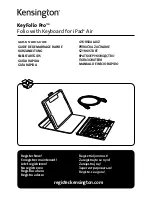
Safe-T-Scope
®
Backup Camera System
STSK7360
1. Connect the red wire to an ignition switched accessory (ex: radio) power source,
and connect the black wire to chassis ground. See wiring diagram for connections
(See Fig. 5.)
2. Before drilling, be sure no cable or wire is on the other side. Be sure to drill
a 20mm (0.8in) diameter hole only.
3. Feed as much cable as possible into vehicle and clamp securely. This
reduces the possibility of it being hooked or snagged.
4. Keep all cables away from HOT, ROTATING and ELECTRICALLY NOISY
components.
5. Camera: Drill a 20mm (0.8in) diameter hole into vehicle body near the camera and
bracket. Insert camera cable into vehicle (be careful not to kink cable) and fit
grommet into hole. Apply sealant around grommet to increase resistance to water
penetration. Connect camera to the camera extension cable which runs inside
the vehicle.
6. Monitor: The monitor terminates in a 13-pin connector, which should be connected
to the mating 13-pin receptacle end of the power/video/audio distribution harness.
7. For typical rear-view installation, connect the camera extension cable
from the rear-view camera to the harness’s connector marked REVERSE.
8. For multi-camera installations, be sure to mark each extension cable properly and
connect to the appropriate harness connector marked CA1 or CA2. Bundle excess
cable together using a cable tie or electrical tape.
9. The green wire is the REVERSE trigger wire. In typical rear-view installations,
connecting this wire to the vehicle’s backup light circuit will activate the rear-view
image whenever the vehicle shifts into reverse.
10. FUEL TANKERS & OTHER SPECIALTY VEHICLES: All electrical equipment
fitted to petroleum vehicles must be connected via battery master switch and must
be isolated from the battery while the vehicle are loading and unloading. For other
specialty vehicles, please check applicable code and regulations prior
to installation.
11. Always consult your dealer when fitting any electrical or electronic equipment to a
vehicle fitted with a CAN-bus or multiplex system.
IMPORTANT: FOR INSTALLATIONS REQUIRING MULTIPLE CAMERAS, OR FOR
INSTALLATIONS NOT REQUIRING TYPICAL REAR-VIEW IMAGES, PLEASE REFER
TO THE WIRING DIAGRAM (FIG.5) AND THE PARTICULAR VEHICLE’S
ELECTRICAL SCHEMATIC FOR SELECTION OF PROPER POWER AND TRIGGER
CONNECTION POINTS.
WIRING CAMERA AND MONITOR
7
MONITOR FUNCTIONS AND OPERATIONS
MONITOR
1.
POWER
When the ignition is switched on, the monitor will be in standby mode (no image
will be on the screen), waiting for trigger signal.
When a trigger wire is energized by 12v power (such as backup lights turning on),
the image captured by the selected camera will appear on the monitor.
2. Pressing the power switch will change the monitor status from standby to
steady-on. Steady-on mode status will show rear cameras view.
3.
/-
Adjust Speaker Volume
These buttons are also used to adjust the values within selected setting of menu option
4.
MODE
Switching the screen mode.
Press MODE once
Full screen changes to 2 split screen.
Press Mode twice
2 slpit screen changes to 3 split screen.
Press Mode three times
3 split screen changes to 4 split screen.
Press Mode four times
4 split screen changes back to full screen.
SPLIT SCREEN & CAMERA FUNCTION
1.
SPLIT SCREEN SWITCH
In the split screen, press button to view the alternate split screen views
half view
1
tri view
1
quad view
1
quad view
2
tri view
2
half view
2
8

































